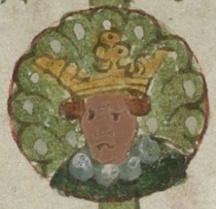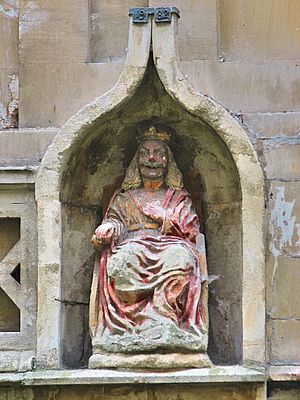Bladud facts for kids
Bladud or Blaiddyd is a legendary king of the Britons. There is no real historical proof that he existed. He is first mentioned in a very old book called Historia Regum Britanniae (around 1136). This book was written by Geoffrey of Monmouth.
Geoffrey's story says Bladud was the son of King Rud Hud Hudibras. He was also the tenth king after the first king, Brutus. Bladud's name, Blaiddyd, means "Wolf-lord" in Welsh. The legend says he founded the city of Bath. His son, Leir, who later became famous as Shakespearean King Lear, became king after him.
Over time, other writers like John Hardyng and John Higgins added more details to Bladud's story.
Contents
The Legend of King Bladud
The legend of Bladud grew over many years. One popular version appeared in John Hardyng's Chronicles in 1457. This story says Bladud's father sent him to study in Athens, Greece.
When his father died, Bladud came back with four wise teachers. He supposedly started a university in Stamford, Lincolnshire. This university was said to have done well for a while.
Bladud and the City of Bath
Bladud is said to have ruled for twenty years. Some stories say this was around 863 BC or even 500 BC. During his rule, he supposedly built a city called Kaerbadum or Caervaddon. Today, we know this city as Bath.
The legend claims he created the famous hot springs in Bath using magic. He dedicated the city to the goddess Athena or Minerva. To honor her, he lit fires that never went out. When the flames got low, they supposedly turned into stone balls, and new fires would appear. This part of the story might come from old tales about how people used local coal on altars in the temple.
How Bladud Found the Hot Springs
The story says Bladud founded Bath because he got leprosy while studying in Athens. When he returned home, he was put in prison because of his illness. But he managed to escape and went into hiding.
He found a job as a swineherd (someone who looks after pigs) in a place called Swainswick. This was about two miles from where Bath is now. He noticed that his pigs would go into a muddy, wet area when it was cold. They would come back covered in warm, black mud.
Bladud saw that the pigs who used this mud did not get skin diseases like the others. So, he tried the mud bath himself. He found that it cured his leprosy! After this, he was able to return to his family and become the next king. He then founded Bath so that other people could also benefit from the healing mud and warm waters.
This story about Bladud's cure became very popular when Bath became a fashionable spa resort. The statue of King Bladud at the King's Bath in Bath is dated 1699, but it is actually much older. It was made from parts of two different statues. Its worn look made it seem even more connected to old stories of healing.
In the 1700s, John Wood, a famous architect who designed many buildings in Bath, celebrated Bladud's legend. He included many references to the king in his designs.
Bladud's Attempt to Fly
The legend also says that Bladud was interested in necromancy. This was a practice of trying to tell the future using the spirits of the dead. Through this practice, he supposedly built wings for himself.
He then tried to fly to (or from) the temple of Apollo in Trinovantum (which is now London). But the story ends sadly. Bladud either hit a wall, fell, or broke his neck and died. He was supposedly buried in London. His son, Leir, became king after him.
In Fiction
Bladud's story has inspired many writers:
- Vera Chapman wrote a fantasy novel about him called Blaedud the Birdman.
- Moyra Caldecott wrote The Winged Man, which is a fictional story about Bladud's life.
- Bladud, known as Blaiddyd, is also a legendary hero in the video game Fire Emblem: Three Houses.
See also
- List of legendary rulers of Cornwall
- Pseudohistorical
- Nennius
- King of the Britons



